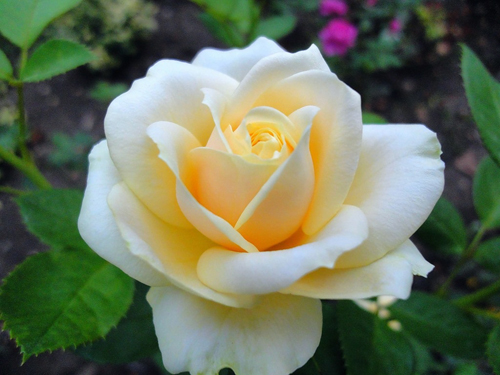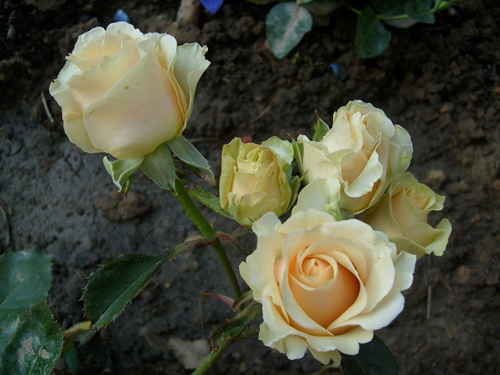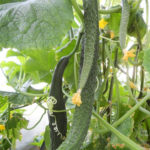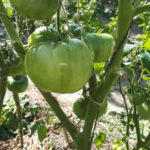Rose Primadonna
At all times, the rose was considered the queen of flowers. And this is absolutely true, especially today, when, through the efforts of breeders, more and more varieties of an amazing flower appear. Let's get acquainted with one of these, which more deserves such a proud title - with a variety of Prima donna.

History of creation
The variety, about which our story will go, belongs to the tea-hybrid group. It was bred in 2003 in the Netherlands. The direct producer of this miracle is the Lex Voorn rose company, which has been successfully developing for over 25 years. Another name for the Prima Donna is Lexannod.
Description of appearance
A noble plant that can take its rightful place in your garden or flower garden, forms a straight-growing, symmetrical bush, not exceeding 60 cm in width. The height of a rose ranges from 0.8 to 1.2 meters. The leaves appear mostly in the upper part of the bush, have a pleasant green tint, without pronounced gloss. The plant is distinguished by the presence of a uniform crown, straight rigid shoots, each of which bears at the end one fairly large flower.
The prima donna pleases the eye with incredibly beautiful and delicate flowers. Their shade can be described as apricot, softened by pink tones. However, someone will be closer to describing the color as "creamy peach". The shade of rounded petals with wavy edges becomes more saturated closer to the middle of the flower. The shape of the rose buds is classic goblet. In the middle, they are quite dense and do not fully open even in the midst of flowering. The size of each bud is 8-10 cm in diameter. They have a lot of petals that form a cap - at least three dozen. The flowers of the culture exude a pleasant, delicate aroma of medium intensity.

Our heroine is perfect for cutting. Shoots with flowers, placed in water, retain their freshness and beautiful appearance for two weeks. Since the stems of the plant are erect and tall, cut roses can be used to create a variety of flower arrangements, including voluminous ones. So, the Diva is a florists' dream, moreover, quite affordable for implementation.
A pleasant feature of this hybrid tea variety for the grower is the abundant and long flowering. In time, this period is several months. This effect is provided mainly due to the gradual blooming of the buds and the preservation of one flower on the stem due to natural characteristics for 12-15 days.
Growing features
A graceful flower is recommended to be planted in the ground in the middle of spring. Bushes are located at a distance of at least half a meter from each other. Shoots are rooted in loose fertile soil. It is best to use loamy soil for this purpose, which has a slightly acidic or neutral reaction. For planting roses, choose a well-lit area, reliably sheltered from the winds. To mask the bareness of the lower part of the stems of the Prima Donna, plant herbaceous annuals around.
Top dressing is carried out throughout the growing season with a frequency of 1 time in 2 weeks, using organic fertilizers. It is important to provide the delicate flower with abundant regular watering. For the winter, it is better to cover the variety, although it has an average winter hardiness. There is a high risk of fungal diseases on the plant, namely black spot and powdery mildew, but it can really be reduced by timely prevention.
Use cases
This variety is often used by landscape designers to create harmonious or, on the contrary, original compositions. To achieve almost continuous and, of course, long flowering, the Prima Donna is planted in the same area with varietal climbing and standard roses. Its combinations with such decorative cultures as delphinium, geranium, sage, catnip, cuff, cypress santolina are also good. Independently, our heroine looks just great too.Do not hesitate, her gentle grace will become the highlight of your flower garden!









The rose is beautiful - a tall "glass", dense petals, delicate color, pleasant aroma. Perfect for cutting and making bouquets (for this I grow roses) - the shoots are strong, long, without thorns. But not everything is so good - in order to get full bloom, you need to work hard, since Bronzovka beetles love to feast on buds (they completely eat them away, and if you do not collect them by hand, you can be left without the first flowering), and besides this, the variety is absolutely not powdery mildew is resistant to the disease (the author advises planting annual plants next to the bushes, but I disagree, they can contribute to the appearance of this disease or worsen ventilation).